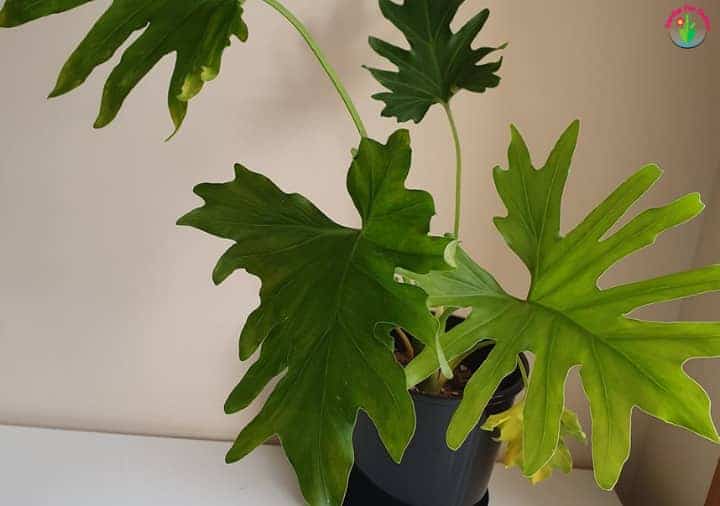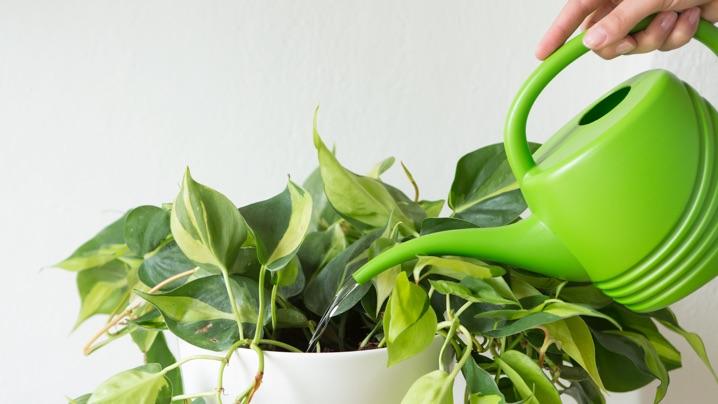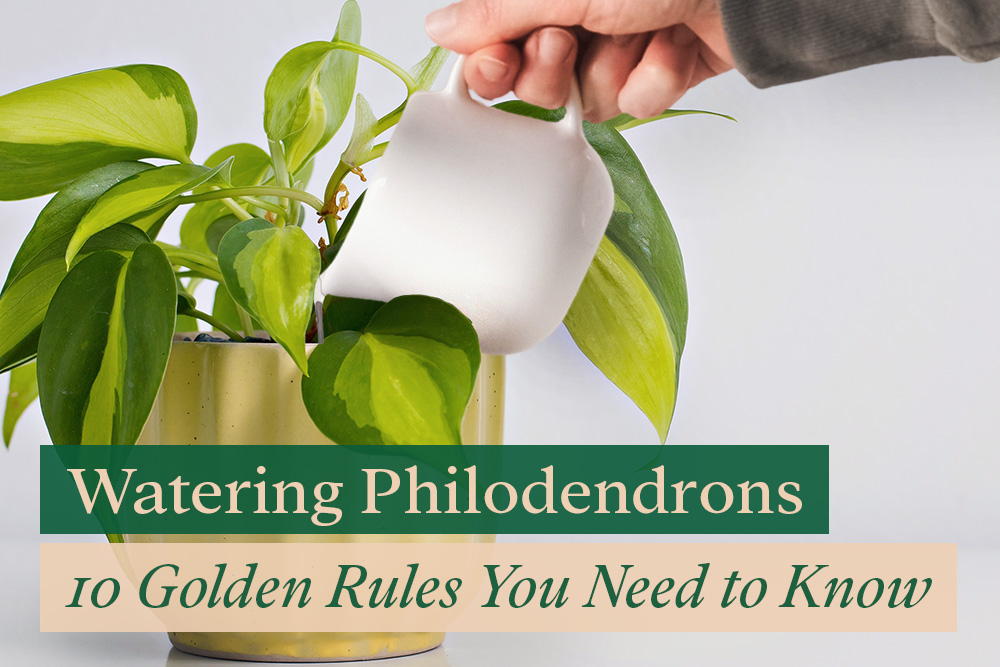In the spring and summer, when philodendrons are actively growing, water them with a deep soak once a week. As philodendrons prefer more humidity, mist the leaves with water twice a week. In the winter, water philodendrons about once every ten days.
Continue reading to discover the best watering techniques and how to determine whether your philodendron is being overwatered or underwatered.
Table of Contents
How Often to Water Philodendron Plants
Philodendrons are indigenous to tropical climes, where they thrive in forested areas with well-draining, porous soils that are damp but not soggy, regular rainfall, and relatively high humidity.
The fact that philodendrons are so well adapted to relatively high humidity and frequent rainfall means that they need the soil to be evenly moist. If the soil becomes dry, they may suffer, displaying signs of stress like brown, drooping leaves, but they may also experience issues due to overwatering if the soil becomes soggy rather than moist and does not drain well.
By often watering, you can successfully grow philodendrons indoors by simulating their natural environment.
Give the philodendron a generous soak, allowing water to seep out of the drainage holes in the base, and then wait for the top 2 inches to slightly dry out before watering it once more. One or two times per week, mist the leaves with water to simulate their natural habitat’s humid microclimate.
Typically, this means giving your philodendron a good soak once a week, but the actual frequency of watering will vary on your environment and the growing circumstances in your home. factors like:
- The climate’s humidity and temperature in your area
- This philodendron’s pot size (smaller pots can dry much quicker then larger pots)
- Whether sources of heat or air conditioning can cause temperature changes in the philodendron.
- the soil’s ability to hold onto moisture.
By using your finger to feel the top 2 inches of the soil, you may determine how frequently to water your philodendron in your climate. Wait to water if the soil is still wet. The ideal time to water your philodendron with a good soak is when the top two inches of the soil feel somewhat dry.
You can create a watering schedule to fit the philodendrons’ watering needs in your home after you know how long it takes for the top two inches of the potting soil to feel somewhat dry.
This replicates the average soil moisture levels found in the philodendrons’ natural habitat.
How to Tell If Your Not Watering Philodendron Often Enough
As tropical plants that like consistently moist soil, philodendrons are more vulnerable to the effects of underwatering than overwatering.
Philodendrons’ leaves can turn dark and droop if they are not given adequate water. Low humidity causes the leaf margins to turn brown, and if the leaf is in a draft or an air conditioning current, this browning may spread to the entire leaf.
If this occurs to your philodendron, it is obvious that you need to water it more frequently and spray it more frequently.
As long as you give the soil a good soak and make sure it is evenly moist for the next several days, philodendrons frequently recover from a period of underwatering nicely.
The philodendron should be exhibiting good indications of healing after two or three watering sessions.
How to Tell if You are Watering Philodendron Too Often
If the leaves of your philodendron are yellowing and drooping, the root ball is likely drowning due to overwatering, slow-draining soils, pots or containers without drainage holes, as well as the usage of saucers, trays, and decorative outer pots.
The issue is more frequently caused by water gathering around the roots because it cannot exit out the bottom of the container rather than just overwatering.
Insufficient oxygen in the soil prevents root respiration and interferes with the roots’ ability to function, which causes the philodendron leaves to yellow and droop. This is because the roots cannot adequately absorb water and nutrients.
(Read my article Why is my philodendron dying for additional information on how to resuscitate your plant.)
How Often to Water Philodendron in Winter
This reduces the philodendron’s need for moisture, so the plant may need less watering throughout the winter. The soil shouldn’t entirely dry out, though.
How frequently you water philodendrons in the winter will vary according on your climate, as some demand sources of heat like forced air and radiators, which can quickly dry out the soil.
In general, watering once every 10 days is ideal because it satisfies the philodendron’s hydration needs without running the risk of root rot.
The philodendron should flourish as long as the top two inches of the soil feel only slightly dry. After that, give the soil a vigorous bath. The air in our houses can get quite dry during the cooler months, so you might need to mist philodendrons a little more frequently during the winter.
How Much to Water Philodendrons
While the frequency of watering your philodendron can change depending on a number of variables, the recommended amount of water is constant.
Philodendrons should always be given a good soak so that any extra water drips out the bottom of the pot.
This guarantees that the water has adequately soaked into the soil, ensuring that it is evenly moist and that the roots can absorb the water the philodendron needs.
Every time you water, give the roots a good bath as well.
The leaves of philodendrons will droop and become brown as a symptom of drought stress if the potting soil is watered too little, barely moistening the top inch or so. This is because the water does not reach the roots deeper in the soil.
Well Draining Soil is Crucial When Watering Philodendrons
To prevent root rot, philodendrons should be grown in the proper potting soil and receive the appropriate amount of water.
In their natural habitat, philodendrons grow in moist but porous, well-draining soil; they cannot accept compacted soil or dirt without an aerated structure because it interferes with the correct operation of the roots.
Philodendrons should be planted with around 3 parts regular potting soil to 1 part perlite. The perlite improves soil drainage and widens soil pores, keeping the soil porous and aerated so that the roots can breathe freely.
The perlite encourages drainage, ensuring that the soil around the root ball is wet rather than soggy to avoid issues brought by by excessive watering.
This soil profile closely resembles the soil profile found in the philodendrons’ natural habitat.
It is much simpler to maintain the ideal moisture balance for philodendrons with the correct potting soil and avoid any negative effects of overwatering to keep your plant healthy.
Water Philodendrons in Pots With Good Drainage
The easiest technique to make sure your philodendron is receiving enough water and that the soil is evenly moist is to water generously until water can be seen trickling from the base of your container.
Your philodendron may eventually die back from root rot if it is planted in pots without drainage holes, which will result in water pooling around the root ball and yellowing leaves.
If: Water may still collect around the potted philodendron’s roots.
- By growing roots or compacting the soil, the drainage holes become closed. It’s worth checking to see whether the hole in the base needs to be cleared if you find that the soil is draining slowly to allow water to properly escape.
- There are trays and saucers under the pot. In your home, saucers and trays placed beneath your pot can avoid water from overflowing, but you should routinely drain them to keep water from accumulating and making the soil too wet for your philodendron.
- outside pots that add style. Philodendrons are frequently sold in plastic pots, however they are displayed in a stylish outer pot that doesn’t have any drainage holes. Always empty the outer pot after watering or plant your philodendron in a container with drainage holes in the base to prevent water from pooling around the root ball caused by the outer pot.
Key Takeaways:
- When they are actively growing in the Spring and Summer, water philodendrons once a week. To raise humidity, mist the philodendron leaves twice a week. During the winter, water philodendrons once every ten days.
- Always give philodendrons a full soak to ensure that the soil is evenly moist. Excess water should seep from the base of the pot.
- To enhance drainage and soil structure, plant philodendrons in a mixture of 3 parts potting soil to 1 part perlite. This aids in simulating the soil’s natural habitat for philodendron plants.
- Philodendron leaves that aren’t getting enough water droop and turn brown to show stress. The leaves droop and become yellow when there is too much moisture around the root ball. For the philodendron to remain healthy, make sure the potting soil is consistently moist.
FAQ
How do you know when a philodendron needs water?
A philodendron’s leaves will appear wilted when it lacks water, so you can tell. The plant will repay you with a vibrant appearance if you water it. Philodendrons also do well in pots filled only with water. Because your philodendron might consume the water more quickly than you expect, keep a constant eye on it.
How much do you water a philodendron?
every week
How often should a philodendron plant be watered?
weekly or biweekly
How much water does a philodendron need?
Philodendrons often require weekly watering. However, depending on the temperature, humidity, and soil quality, different plants may require different amounts of watering. It is better to wait until the soil’s top layer has dried before watering.
What is the best way to water a philodendron?
If the top 50 to 75 percent of the soil is dry, water your philodendron. Pour water into the pot until it begins to drain through the drainage hole at the bottom, then drain any excess water into the saucer. Your Philodendron Birkin can tolerate normal household humidity, but higher humidity encourages bigger leaves.



